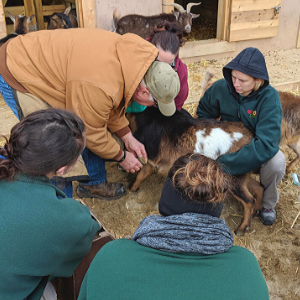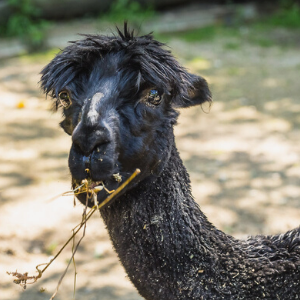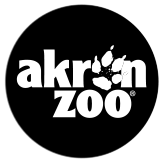Are there horses at the Akron Zoo? Neigh! However, we do have several other hooved animals, or hoofstock, in our care, and since February is International Hoof Care Month, I thought I might tell you a bit more about them!
 At the Akron Zoo we have both domestic and exotic hoofstock species. Domestic hoofstock are bred for herding purposes and include our alpacas, who can be found in Legends of the Wild, and the Nigerian dwarf goats, who live in the Boma in Pride of Africa. When visiting, guests may notice that there is a considerable size difference between some of our goats. Although the four smallest goats are not yet fully grown, they are a breed of Nigerian dwarf goat, called Nigerian pygmy dwarf goat (pygmy goat, for short), and they won’t grow to be much larger than their current size. The zoo’s exotic hoofstock species include our Speke’s gazelles, who reside in the Pride of Africa mixed species habitat, and the Himalayan tahr and Siberian musk deer, who can be found in their respective habitats in Legends of the Wild.
At the Akron Zoo we have both domestic and exotic hoofstock species. Domestic hoofstock are bred for herding purposes and include our alpacas, who can be found in Legends of the Wild, and the Nigerian dwarf goats, who live in the Boma in Pride of Africa. When visiting, guests may notice that there is a considerable size difference between some of our goats. Although the four smallest goats are not yet fully grown, they are a breed of Nigerian dwarf goat, called Nigerian pygmy dwarf goat (pygmy goat, for short), and they won’t grow to be much larger than their current size. The zoo’s exotic hoofstock species include our Speke’s gazelles, who reside in the Pride of Africa mixed species habitat, and the Himalayan tahr and Siberian musk deer, who can be found in their respective habitats in Legends of the Wild.
It is important that we check our animals’ hooves routinely. Right now, we check them about once every two months. During this check we inspect the hooves for overgrowth, cleanliness (rocks and dirt wedged into spaces), and any injuries or tears. We clean out anything we find in crevices to make sure there is no cause for infection. When we see overgrowth on their hooves, we trim it back using small hoof trimmers and files, called rasps. Recently, a local farrier, Barry Barnett, trained the Hoofstock Team on how to properly check goat hooves and trim them.
We are also in the process of initiating new training goals with all of our hoofstock animals. These goals are set based on the specific needs of the species we are working with, and the needs of each individual animal. For example, all of our hoofstock need weighed routinely, so we have been working with them to voluntarily step onto and off of a scale. This training allows us to record and track their weight whenever we need to without causing any stress to the animals.
 Since we tailor our training to the individual animals we work with, a knowledge of their training history and behavior is crucial. For example, Noel (left), one of our alpacas, is not yet comfortable around his scale. Before we can train him to step on the scale, we have to start with getting him comfortable in the presence of the scale.
Since we tailor our training to the individual animals we work with, a knowledge of their training history and behavior is crucial. For example, Noel (left), one of our alpacas, is not yet comfortable around his scale. Before we can train him to step on the scale, we have to start with getting him comfortable in the presence of the scale.
We also need to take into consideration what reward each individual prefers. Tasty produce like apples and carrots is often rewarding to many hoofstock animals, but some individuals (like Noel) prefer to be rewarded with a handful of alfalfa hay. Knowing what rewards are most positive for an individual is important because they are used to reinforce the behaviors we are training them to do.
You may catch me and my teammates working on training with our hoofstock while you are visiting the zoo. If so, please stick around and check out the training. After we finish, we would be happy to answer any questions you may have and tell you more about our wonderful hoofstock!
